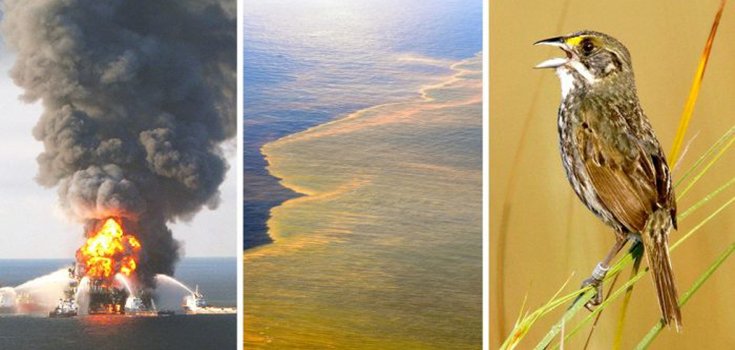Oil from BP Spill Has Been Found in Terrestrial Birds

It’s been more than six years since the Deepwater Horizon oil rig exploded, killing 11 workers and dumping some 700,000 cubic feet (ca.154 million gallons) of oil into the Gulf of Mexico.
The hearts of people worldwide broke at the sight of oil-covered pelicans and dolphins swimming in oil slicks. That was only the beginning of the environmental damage, however. Now carbon from the spill has been found in the feathers and digestive tracts of seaside sparrows. [1]
The oil has officially entered the food chain.
Researchers from Louisiana State University and Austin Peay State University in Tennessee write in a study published in Environmental Research Letters that they found oil carbon signatures consistent with the BP oil spill in each of 10 sparrows tested. The birds live in the Louisiana marshes. [2]
They say it “is the first demonstration that oil from the spill made it into the” food chain of land animals. [1]
The team analyzed contaminated sediments to identify a chemical “fingerprint” from Deepwater Horizon. From there, the researchers examined the birds’ feathers and digestive tract contents to determine how much oil had been incorporated into the sparrows’ biological tissue.
Lead study author Andrea Bonisoli Alquati was a doctoral student at Louisiana State University when the research was done. After obtaining his Ph.D., he became an environmental toxicologist at California State Polytechnic University. He said of the discovery:
“These results are consistent with the incorporation of Deepwater Horizon oil into the tissues of the exposed birds.”
Read: “Horrific”: Gulf of Mexico Dead Zone Now the Size of Connecticut
Bonisoli Alquati continued:
“We’re dealing with a terrestrial bird – not the classic shorebird or the marine bird that you would expect to be in contact with oil. So the terrestrial food web is also contaminated, and this is something we don’t typically think of.” [3]
The sparrows live in the salt marshes year-round, so the health of the birds is a pretty good indicator of the health of the marshes. Researchers knew shortly after the spill that the sparrows had been affected – they stopped raising the normal number of offspring – but investigators couldn’t determine whether that was an indirect, ecological effect.
Insect populations that served as a food source for the sparrows dropped after the disaster. Many insects spend their larval stages in the water, where they would come into contact with the oil.
Read: Dolphin Deaths in Gulf Caused by BP Oil Spill
“The first signs of Deepwater Horizon oil were found in blue crab larvae in 2010. Oil likely entered the food chain through zooplankton. A 2012 study found traces of oil in zooplankton impacted by the BP oil spill.”
It’s a safe bet that the toxins are directly affecting the health of the birds. Bonisoli Alquati said that the birds perhaps feel sick and are unable to properly care for their young. Their bodies may be spending extra energy trying to counteract the damaging effects of the oil, leaving the birds less energy for producing eggs and raising chicks. [3]
And although the sample size is rather small, it still helps researchers understand how the oil spill has affected wetland and terrestrial life.
Scott Zengel, a coastal ecologist with Research Planning, Inc., an environmental consulting firm that specializes in oil spills, said:
“At least for Deepwater Horizon, there’s been a lot more emphasis on marine or offshore-type resources, and a little bit less emphasis on wildlife species in shore — particularly in the marshes and coastal wetlands.” [3]
Bonisoli Alquati said that the lack of emphasis means that the connection between species in different ecosystems has been underestimated.
“Boundaries between other ecosystems are much more blurred than we recognize.”
Sources:
[1] BBC News
[2] EcoWatch (featured image source)
[3] Inside Science
